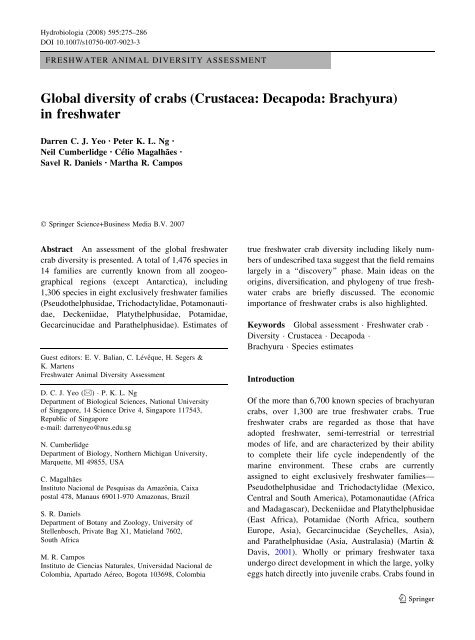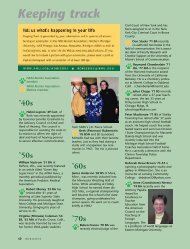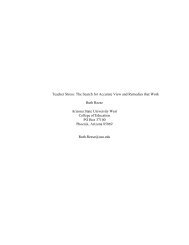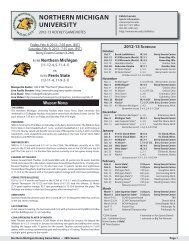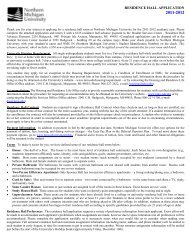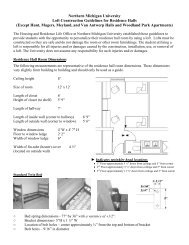Global diversity of crabs (Crustacea: Decapoda: Brachyura) in ...
Global diversity of crabs (Crustacea: Decapoda: Brachyura) in ...
Global diversity of crabs (Crustacea: Decapoda: Brachyura) in ...
You also want an ePaper? Increase the reach of your titles
YUMPU automatically turns print PDFs into web optimized ePapers that Google loves.
Hydrobiologia (2008) 595:275–286<br />
DOI 10.1007/s10750-007-9023-3<br />
FRESHWATER ANIMAL DIVERSITY ASSESSMENT<br />
<strong>Global</strong> <strong>diversity</strong> <strong>of</strong> <strong>crabs</strong> (<strong>Crustacea</strong>: <strong>Decapoda</strong>: <strong>Brachyura</strong>)<br />
<strong>in</strong> freshwater<br />
Darren C. J. Yeo Æ Peter K. L. Ng Æ<br />
Neil Cumberlidge Æ Célio Magalhães Æ<br />
Savel R. Daniels Æ Martha R. Campos<br />
Ó Spr<strong>in</strong>ger Science+Bus<strong>in</strong>ess Media B.V. 2007<br />
Abstract An assessment <strong>of</strong> the global freshwater<br />
crab <strong>diversity</strong> is presented. A total <strong>of</strong> 1,476 species <strong>in</strong><br />
14 families are currently known from all zoogeographical<br />
regions (except Antarctica), <strong>in</strong>clud<strong>in</strong>g<br />
1,306 species <strong>in</strong> eight exclusively freshwater families<br />
(Pseudothelphusidae, Trichodactylidae, Potamonautidae,<br />
Deckeniidae, Platythelphusidae, Potamidae,<br />
Gecarc<strong>in</strong>ucidae and Parathelphusidae). Estimates <strong>of</strong><br />
Guest editors: E. V. Balian, C. Lévêque, H. Segers &<br />
K. Martens<br />
Freshwater Animal Diversity Assessment<br />
D. C. J. Yeo (&) P. K. L. Ng<br />
Department <strong>of</strong> Biological Sciences, National University<br />
<strong>of</strong> S<strong>in</strong>gapore, 14 Science Drive 4, S<strong>in</strong>gapore 117543,<br />
Republic <strong>of</strong> S<strong>in</strong>gapore<br />
e-mail: darrenyeo@nus.edu.sg<br />
N. Cumberlidge<br />
Department <strong>of</strong> Biology, Northern Michigan University,<br />
Marquette, MI 49855, USA<br />
C. Magalhães<br />
Instituto Nacional de Pesquisas da Amazônia, Caixa<br />
postal 478, Manaus 69011-970 Amazonas, Brazil<br />
S. R. Daniels<br />
Department <strong>of</strong> Botany and Zoology, University <strong>of</strong><br />
Stellenbosch, Private Bag X1, Matieland 7602,<br />
South Africa<br />
M. R. Campos<br />
Instituto de Ciencias Naturales, Universidad Nacional de<br />
Colombia, Apartado Aéreo, Bogota 103698, Colombia<br />
true freshwater crab <strong>diversity</strong> <strong>in</strong>clud<strong>in</strong>g likely numbers<br />
<strong>of</strong> undescribed taxa suggest that the field rema<strong>in</strong>s<br />
largely <strong>in</strong> a ‘‘discovery’’ phase. Ma<strong>in</strong> ideas on the<br />
orig<strong>in</strong>s, diversification, and phylogeny <strong>of</strong> true freshwater<br />
<strong>crabs</strong> are briefly discussed. The economic<br />
importance <strong>of</strong> freshwater <strong>crabs</strong> is also highlighted.<br />
Keywords <strong>Global</strong> assessment Freshwater crab<br />
Diversity <strong>Crustacea</strong> <strong>Decapoda</strong><br />
<strong>Brachyura</strong> Species estimates<br />
Introduction<br />
Of the more than 6,700 known species <strong>of</strong> brachyuran<br />
<strong>crabs</strong>, over 1,300 are true freshwater <strong>crabs</strong>. True<br />
freshwater <strong>crabs</strong> are regarded as those that have<br />
adopted freshwater, semi-terrestrial or terrestrial<br />
modes <strong>of</strong> life, and are characterized by their ability<br />
to complete their life cycle <strong>in</strong>dependently <strong>of</strong> the<br />
mar<strong>in</strong>e environment. These <strong>crabs</strong> are currently<br />
assigned to eight exclusively freshwater families—<br />
Pseudothelphusidae and Trichodactylidae (Mexico,<br />
Central and South America), Potamonautidae (Africa<br />
and Madagascar), Deckeniidae and Platythelphusidae<br />
(East Africa), Potamidae (North Africa, southern<br />
Europe, Asia), Gecarc<strong>in</strong>ucidae (Seychelles, Asia),<br />
and Parathelphusidae (Asia, Australasia) (Mart<strong>in</strong> &<br />
Davis, 2001). Wholly or primary freshwater taxa<br />
undergo direct development <strong>in</strong> which the large, yolky<br />
eggs hatch directly <strong>in</strong>to juvenile <strong>crabs</strong>. Crabs found <strong>in</strong><br />
123
276 Hydrobiologia (2008) 595:275–286<br />
freshwater also <strong>in</strong>clude numerous euryhal<strong>in</strong>e species<br />
or secondary freshwater species from primarily<br />
mar<strong>in</strong>e brachyuran families (e.g. Sesarmidae, Varunidae,<br />
Hymenosomatidae). Although these<br />
freshwater species are fully adapted to freshwater/<br />
terrestrial liv<strong>in</strong>g, most do not have direct development<br />
<strong>in</strong> their life cycle (though highly abbreviated<br />
development occurs <strong>in</strong> some) and most possess one or<br />
more larval stages. The <strong>diversity</strong> <strong>of</strong> these taxa is also<br />
assessed <strong>in</strong> this chapter (Tables 1 and 2), but the<br />
emphasis will be placed on the true freshwater <strong>crabs</strong>.<br />
Freshwater <strong>crabs</strong> belong to the Order <strong>Decapoda</strong>, the<br />
crustacean group that also <strong>in</strong>cludes lobsters, prawns,<br />
crayfish and hermit <strong>crabs</strong>, which share the characteristic<br />
presence <strong>of</strong> five pairs <strong>of</strong> thoracic legs (pereiopods).<br />
In freshwater <strong>crabs</strong> the first pereiopods are modified as<br />
p<strong>in</strong>cers (chelipeds), and the rema<strong>in</strong><strong>in</strong>g four pairs are<br />
relatively unspecialised walk<strong>in</strong>g legs (Fig. 1). The<br />
general body plan <strong>of</strong> freshwater <strong>crabs</strong> consists <strong>of</strong> a<br />
head, thorax and abdomen, with the head and thorax<br />
(cephalothorax) covered by a broad carapace, and the<br />
abdomen reduced, flattened and flexed under the<br />
thoracic sternum. In adults, the male abdomen is slim<br />
and narrow, and is either triangular or T-shaped, while<br />
the female abdomen is broad and round and covers<br />
nearly the entire thoracic sternum. Adult males bear<br />
two pairs <strong>of</strong> abdom<strong>in</strong>al appendages (pleopods) that are<br />
modified <strong>in</strong>to copulatory structures known as gonopods.<br />
Gonopod structure is taxonomically important,<br />
especially because the external morphology <strong>of</strong> freshwater<br />
<strong>crabs</strong> tends to be rather conservative (see Ng,<br />
1988; Cumberlidge, 1999, for details).<br />
Freshwater <strong>crabs</strong> are found <strong>in</strong> the tropics and<br />
subtropics <strong>in</strong> most parts <strong>of</strong> the world, and occur <strong>in</strong> a<br />
wide variety <strong>of</strong> aquatic and terrestrial habitats. These<br />
decapods are present <strong>in</strong> almost all freshwater bodies,<br />
from clear, fast-flow<strong>in</strong>g montane streams to sluggish<br />
lowland rivers and streams, as well as <strong>in</strong> peat and<br />
freshwater swamps, stagnant ponds and rice fields,<br />
and even <strong>in</strong> pools <strong>in</strong> tree holes and leaf axils. A fair<br />
number are also adapted to live <strong>in</strong> caves. Among the<br />
primarily aquatic freshwater <strong>crabs</strong>, some (e.g. potamids)<br />
are entirely adapted to liv<strong>in</strong>g <strong>in</strong> fresh water,<br />
and are not thought to be able to survive for long <strong>in</strong><br />
salt water, while others (e.g. parathelphusids) are<br />
more tolerant <strong>of</strong> sal<strong>in</strong>e conditions, and can survive<br />
immersion <strong>in</strong> salt water for short periods <strong>of</strong> time.<br />
Terrestrial species may occur well away from<br />
permanent freshwater sources, either mov<strong>in</strong>g among<br />
123<br />
the forest floor litter or, <strong>in</strong> some cases, even climb<strong>in</strong>g<br />
trees (Ng, 1988; Ng & Tay, 2001; Cumberlidge et al.,<br />
2005). These freshwater crab species do not require<br />
regular immersion <strong>in</strong> fresh water and can obta<strong>in</strong><br />
water either from food, from dr<strong>in</strong>k<strong>in</strong>g dew or casual<br />
water, or by capillary or osmotic uptake from moist<br />
substrata. In the present chapter, such species are also<br />
categorised as ‘‘freshwater-dependent’’ species (see<br />
later; Table 1).<br />
Freshwater <strong>crabs</strong> are primarily nocturnal, preferr<strong>in</strong>g<br />
to rema<strong>in</strong> hidden dur<strong>in</strong>g the day <strong>in</strong> sheltered<br />
places and forag<strong>in</strong>g mostly at night. They are mostly<br />
omnivorous scavengers, ma<strong>in</strong>ly feed<strong>in</strong>g on plant<br />
matter, but some are opportunistic carnivores, feed<strong>in</strong>g<br />
either on live prey such as fish and prawns or on dead<br />
animals that they encounter (Ng, 1988; unpub.), and<br />
cannibalism is not uncommon (unpub.). Crabs themselves<br />
also constitute an important food resource for<br />
many species <strong>of</strong> fishes, birds, caymans, turtles and<br />
mammals (see Ng, 1988; Magalhães, 2003).<br />
Diversity and endemicity<br />
Known global <strong>diversity</strong><br />
There are currently a total <strong>of</strong> 238 genera and 1,476<br />
species <strong>of</strong> known freshwater <strong>crabs</strong> from 14 families<br />
(<strong>in</strong>clud<strong>in</strong>g 1,306 true freshwater crab species <strong>in</strong> eight<br />
families: Pseudothelphusidae, Trichodactylidae,<br />
Potamonautidae, Deckeniidae, Platythelphusidae, Potamidae,<br />
Gecarc<strong>in</strong>ucidae and Parathelphusidae) (as <strong>of</strong> 1st<br />
August 2006). The species and genus <strong>diversity</strong> <strong>of</strong><br />
primary as well as secondary freshwater species are<br />
listed by zoogeographical regions (sensu Cox, 2001) <strong>in</strong><br />
Tables 1 and 2, respectively. The total number <strong>of</strong><br />
species or genera <strong>of</strong> certa<strong>in</strong> families listed <strong>in</strong> the last<br />
column <strong>of</strong> Tables 1 and 2, respectively, do not tally<br />
with the sum <strong>of</strong> species or genera from each zoogeographical<br />
region because some taxa occur <strong>in</strong> more than<br />
one region (see later, Tables 1 and 2 footnotes).<br />
Table 1 also lists separately the number <strong>of</strong><br />
‘‘freshwater-dependent’’ species (WDpt). In the<br />
context <strong>of</strong> the present volume, our assessment <strong>of</strong><br />
the freshwater crab species required group<strong>in</strong>g<br />
them <strong>in</strong>to two broad ecological categories to reflect<br />
their different habitat preferences and degrees<br />
<strong>of</strong> their association with freshwater habitats, viz.,<br />
‘‘real aquatic’’ species and ‘‘freshwater-dependent’’
Hydrobiologia (2008) 595:275–286 277<br />
Table 1 <strong>Global</strong> species <strong>diversity</strong> <strong>of</strong> freshwater <strong>crabs</strong><br />
Family PA NA NT AT OL AU PAC World c<br />
Total FW WDpt Total FW WDpt Total FW WDpt Total FW WDpt Total FW WDpt Total FW WDpt Total FW WDpt Total FW WDpt<br />
86 – – – – – 3 1 435 58 – – – – 509 59<br />
a Potamidae d<br />
a Potamonautidae – – – – – – 115 9 – – – – – – 115 9<br />
a Deckeniidae – – – – – – 2 2 – – – – – – 2 2<br />
a Platythelphusidae – – – – – – 9 – – – – – – – 9 –<br />
4 – – – – – – – 243 14 52 8 – – 298 22<br />
a Parathelphusidae e<br />
a Gecarc<strong>in</strong>ucidae – – – – – – 8 6 36 3 – – – – 44 9<br />
a Pseudothelphusidae – – 16 – 262 3 – – – – – – – – 278 3<br />
a Trichodactylidae – – – – 51 – – – – – – – – – 51 –<br />
– – 3 3 9 9 9 9 8 8 6 6 8 8 20 20<br />
b Gecarc<strong>in</strong>idae f<br />
1 – – – 1 – 1 – 8 – 9 – 3 – 22 –<br />
b Hymenosomatidae g<br />
b Ocypodidae – – – – – – – – 2 – – – – – 2 –<br />
2 – – – 14 14 1 1 72 68 15 13 7 7 101 95<br />
b Sesarmidae h<br />
b Goneplacidae – – – – – – – – – – 2 – 2 – 4 –<br />
4 – – – 3 – 1 – 14 – 5 – 4 – 21 –<br />
b Varunidae i<br />
97 – 19 3 340 26 149 28 818 151 89 27 24 15 1476 219<br />
Total j<br />
Total FW: Aquatic + ’’freshwater dependent’’ species. WDpt: ‘‘freshwater-dependent’’ species (see text under ‘‘Known global <strong>diversity</strong>’’ for def<strong>in</strong>ition). PA: Palaearctic, NA:<br />
Nearctic, NT: Neotropical, AT: Afrotropical, OL: Oriental, AU: Australasian, PAC: Pacific Oceanic Islands<br />
a<br />
True (or primary) freshwater crab family<br />
b<br />
Secondary freshwater crab family<br />
c<br />
‘‘World’’ refers to the actual total number <strong>of</strong> freshwater species, which may not necessarily be the sum <strong>of</strong> the totals for each zoogeographical region as some species occur <strong>in</strong><br />
more than one region (see text)<br />
d<br />
Potamidae—15 species with Palaearctic/Oriental distributions<br />
e<br />
Parathelphusidae—1 species with Palaearctic/Oriental distribution<br />
f<br />
Gecarc<strong>in</strong>idae—13 species with various overlapp<strong>in</strong>g distributions (3 Nearctic/Neotropical + 4 Afrotropical/Neotropical + 4 Afrotropical/Oriental/Australasian/Pacific + 2<br />
Oriental/Australasian/Pacific)<br />
g<br />
Hymenosomatidae—1 species with Neotropical/Australasian distribution<br />
h<br />
Sesarmidae—6 species with various overlapp<strong>in</strong>g distributions (1 Palaearctic/Oriental/Australasian + 1 Afrotropical/Oriental/Australasian + 1 Oriental/Australasian + 2<br />
Oriental/Australasian/Pacific + 1 Australasian/Pacific)<br />
i<br />
Varunidae—7 species with various overlapp<strong>in</strong>g distributions (3 Palaearctic/Oriental + 1 Palaearctic/Afrotropical/Oriental/Australasian/Pacific + 3 Oriental/Australasian)<br />
j Total—43 species with various overlapp<strong>in</strong>g distributions (see above for details)<br />
123
278 Hydrobiologia (2008) 595:275–286<br />
Table 2 <strong>Global</strong> genus <strong>diversity</strong> <strong>of</strong> freshwater <strong>crabs</strong><br />
Family PA NA NT AT OL AU PAC World c<br />
a Potamidae d<br />
Fig. 1 Habitus<br />
9 – – 2 72 – – 78<br />
a Potamonautidae – – – 12 – – – 12<br />
a Deckeniidae – – – 1 – – – 1<br />
a Platythelphusidae – – – 1 – – – 1<br />
a Parathelphusidae e<br />
1 – – – 35 9 – 42<br />
a Gecarc<strong>in</strong>ucidae – – – 4 10 – – 14<br />
a Pseudothelphusidae f<br />
– 2 41 – – – – 41<br />
a Trichodactylidae – – 15 – – – – 15<br />
b Gecarc<strong>in</strong>idae g<br />
b Hymenosomatidae h<br />
– 2 3 4 4 4 4 6<br />
1 – 1 1 3 2 2 6<br />
b Ocypodidae – – – – 1 – – 1<br />
b Sesarmidae i<br />
b Goneplacidae j<br />
b Varunidae k<br />
Total l<br />
1 – 3 1 7 4 3 10<br />
– – – – – 1 2 2<br />
2 – 2 1 7 4 2 9<br />
14 4 65 27 139 24 13 238<br />
PA: Palaearctic, NA: Nearctic, NT: Neotropical, AT: Afrotropical, OL: Oriental, AU: Australasian, PAC: Pacific Oceanic Islands<br />
a<br />
True (or primary) freshwater crab family<br />
b<br />
Secondary freshwater crab family<br />
c<br />
‘‘World’’ refers to the actual total number <strong>of</strong> freshwater genera, which may not necessarily be the sum <strong>of</strong> the totals for each<br />
zoogeographical region as some genera occur <strong>in</strong> more than one region (see text)<br />
d<br />
Potamidae—5 genera with Palaearctic/Oriental distributions<br />
e<br />
Parathelphusidae—3 genera with various overlapp<strong>in</strong>g distributions (1 Palaearctic/Oriental + 2 Oriental/Australasian)<br />
f<br />
Pseudothelphusidae—2 genera with Nearctic/Neotropical distributions<br />
g<br />
Gecarc<strong>in</strong>idae—6 genera with various overlapp<strong>in</strong>g distributions (1 Nearctic/Neotropical + 1 Nearctic/Afrotropical/Neotropical/<br />
Oriental/Australasian/Pacific + 1 Afrotropica/Neotropical + 2 Afrotropical/Oriental/Australasian/Pacific + 1 Oriental/Australasian/<br />
Pacific)<br />
h<br />
Hymenosomatidae—2 genera with different overlapp<strong>in</strong>g distributions (1 Palaearctic/Oriental/Pacific + 1 Neotropical/Oriental/<br />
Australasian)<br />
i<br />
Sesarmidae—4 genera with various overlapp<strong>in</strong>g distributions (1 Palaearctic/Oriental/Australasian + 1 Afrotropical/Oriental/<br />
Australasian/Pacific + 2 Oriental/Australasian/Pacific)<br />
j<br />
Goneplacidae—1 genus with Australasian/Pacific distribution<br />
k<br />
Varunidae—6 genera with various overlapp<strong>in</strong>g distributions (1 Palaearctic/Oriental + 1 Palaearctic/Afrotropical/Oriental/<br />
Australasian/Pacific + 3 Oriental/Australasian + 1 Oriental/Pacific)<br />
l<br />
Total—29 genera with various overlapp<strong>in</strong>g distributions (see above for details)<br />
123<br />
species. ‘‘Real aquatic’’ species are ones that are<br />
dependent on freshwater habitats to complete their<br />
life cycle i.e. part or all <strong>of</strong> the life cycle occurs <strong>in</strong> the<br />
water. Thus, adopt<strong>in</strong>g a practical approach, this study<br />
has <strong>in</strong>cluded under ‘‘real aquatic’’ species all fully<br />
aquatic as well as semi-terrestrial species that are<br />
generally found <strong>in</strong> and around (or associated with)<br />
traditional freshwater environments (streams, rivers,<br />
lakes, ponds, swamps). Under ‘‘freshwater-dependent’’<br />
species (WDpt), this work has <strong>in</strong>cluded the<br />
more terrestrial species <strong>in</strong> which the adults are not
Hydrobiologia (2008) 595:275–286 279<br />
primarily found <strong>in</strong> and around (or associated with)<br />
traditional freshwater environments, but are nevertheless<br />
dependent on wet/humid terrestrial<br />
environments for survival e.g. tree-climb<strong>in</strong>g <strong>crabs</strong>,<br />
forest floor dwellers, dry cave dwellers. These<br />
<strong>in</strong>clude many so-called terrestrial <strong>crabs</strong> that have<br />
juvenile stages that can occur <strong>in</strong> water.<br />
Estimated global bio<strong>diversity</strong><br />
Two methods are proposed here for estimat<strong>in</strong>g the<br />
global <strong>diversity</strong> <strong>of</strong> true freshwater <strong>crabs</strong>:<br />
(1) Based on extrapolation. Estimated global<br />
<strong>diversity</strong> <strong>of</strong> true freshwater <strong>crabs</strong>: 2,155 species<br />
Yeo & Ng (1999) used the species number per unit<br />
area <strong>of</strong> Thailand (1.8 · 10 4 species/km 2 ) as a<br />
reference for estimat<strong>in</strong>g the fauna for the whole <strong>of</strong><br />
Indoch<strong>in</strong>a. These authors applied this ratio to Indoch<strong>in</strong>a<br />
[=Thailand, Laos, Cambodia, Vietnam and<br />
Myanmar] (1,939,320 km 2 ), and obta<strong>in</strong>ed a work<strong>in</strong>g<br />
estimate <strong>of</strong> 349 species for this region. There are<br />
currently 212 species known from Indoch<strong>in</strong>a (Yeo &<br />
Ng, unpub.) which gives an approximate ratio <strong>of</strong><br />
actual to estimated species <strong>of</strong> 1:1.65. The 13 species<br />
<strong>of</strong> freshwater <strong>crabs</strong> known from Madagascar give a<br />
similar estimate (Cumberlidge & Sternberg, 2002).<br />
Although simplistic, no similar objective estimates<br />
have been attempted thus far. Apply<strong>in</strong>g a ratio <strong>of</strong><br />
actual to estimated species <strong>of</strong> 1:1.65 to the known<br />
true freshwater crab global <strong>diversity</strong> from the previous<br />
section (1,306 species), gives an estimated global<br />
<strong>diversity</strong> <strong>of</strong> 2,155 species. Given that Indoch<strong>in</strong>a lies<br />
<strong>in</strong> one <strong>of</strong> the most species-rich areas <strong>of</strong> the global<br />
range <strong>of</strong> freshwater <strong>crabs</strong>, this figure may tend to be<br />
an overestimate. Consider<strong>in</strong>g the large numbers <strong>of</strong><br />
undescribed species known and/or likely to be<br />
discovered <strong>in</strong> the near future, freshwater crab taxonomy<br />
must be regarded as still be<strong>in</strong>g <strong>in</strong> its<br />
‘‘discovery’’ phase. The cumulative curves <strong>of</strong> new<br />
species described over time for the two South<br />
American crab families suggests that the <strong>diversity</strong><br />
<strong>of</strong> the Pseudothelphusidae is still far from be<strong>in</strong>g wellknown<br />
because the curve (Fig. 2a) is still ascend<strong>in</strong>g.<br />
On the other hand, the curve for the trichodactylids<br />
(Fig. 2b) seems to have already reached an asymptote,<br />
suggest<strong>in</strong>g at least for this group, the discovery<br />
phase is end<strong>in</strong>g. The several phases <strong>of</strong> tectonic uplift<br />
that affected most <strong>of</strong> the western and northern<br />
a<br />
s<br />
e<br />
i<br />
c<br />
e<br />
p<br />
s<br />
f<br />
o<br />
r<br />
e<br />
b<br />
m<br />
u<br />
n<br />
e<br />
v<br />
i<br />
t<br />
a<br />
l<br />
u<br />
m<br />
u<br />
C<br />
160<br />
140<br />
1840-1850<br />
1851-1860<br />
1861-1870<br />
1871-1880<br />
1881-1890<br />
1891-1900<br />
1901-1910<br />
1911-1920<br />
1921-1930<br />
1931-1940<br />
1941-1950<br />
1951-1960<br />
1961-1970<br />
1971-1980<br />
1981-1990<br />
1991-2000<br />
2001-2004<br />
b<br />
s<br />
e<br />
i<br />
c<br />
e<br />
p<br />
s<br />
f<br />
o<br />
r<br />
e<br />
b<br />
m<br />
u<br />
n<br />
e<br />
v<br />
i<br />
t<br />
a<br />
l<br />
u<br />
m<br />
u<br />
C<br />
120<br />
100<br />
80<br />
60<br />
40<br />
20<br />
0<br />
50<br />
45<br />
40<br />
35<br />
30<br />
25<br />
20<br />
15<br />
10<br />
5<br />
0<br />
1783-1800<br />
1801-1850<br />
1851-1900<br />
Pseudothelphusidae<br />
Trichodactylidae<br />
1901-1950<br />
1951-1960<br />
Period<br />
1961-1970<br />
Period<br />
1971-1980<br />
1981-1990<br />
1991-1995<br />
1996-2000<br />
2001-2004<br />
Fig. 2 Cumulative number <strong>of</strong> South American species <strong>of</strong>: (a)<br />
Pseudothelphusidae described s<strong>in</strong>ce 1840; and (b) Trichodactylidae<br />
described s<strong>in</strong>ce 1783<br />
marg<strong>in</strong>s <strong>of</strong> South America produced many vicariance<br />
events (Lundberg et al., 1998) that could account for<br />
the high diversification <strong>of</strong> the pseudothelphusids<br />
along the Andes. Pseudothelphusids are usually<br />
distributed <strong>in</strong> mounta<strong>in</strong>ous regions with restricted<br />
distributional ranges and there still are several<br />
unexplored areas <strong>in</strong> the Andes, Guyana and the<br />
Central Brazilian Massifs from where new taxa are<br />
still be<strong>in</strong>g found. Species <strong>of</strong> trichodactylids usually<br />
have extensive ranges along the relatively uniform,<br />
tectonically stable lowlands <strong>of</strong> the cont<strong>in</strong>ent’s huge<br />
hydrographic bas<strong>in</strong>s, have not speciated as much as<br />
the pseudothelphusids, and the number <strong>of</strong> new<br />
species <strong>of</strong> trichodactylids still await<strong>in</strong>g discovery is<br />
expected to be low.<br />
(2) Based on numbers <strong>of</strong> as yet undescribed<br />
species known. Estimated global <strong>diversity</strong> <strong>of</strong> true<br />
freshwater <strong>crabs</strong>: 1,430 species.<br />
This estimate is based simply on the total number<br />
<strong>of</strong> described and undescribed species <strong>of</strong> true freshwater<br />
<strong>crabs</strong> known to the authors. The breakdown <strong>of</strong><br />
these estimates by family is as follows: Potamidae<br />
123
280 Hydrobiologia (2008) 595:275–286<br />
(570 species); Potamonautidae (135 species); Deckeniidae<br />
(3 species); Platythelphusidae (12 species);<br />
Parathelphusidae (310 species); Gecarc<strong>in</strong>ucidae (60<br />
species); Pseudothelphusidae (289 species) and<br />
Trichodactylidae (51 species). The disparity between<br />
the overall estimates obta<strong>in</strong>ed us<strong>in</strong>g this method<br />
versus the extrapolation method is probably accentuated<br />
by the fact that some <strong>of</strong> our family level<br />
estimates here are conservative. Reality is probably<br />
somewhere <strong>in</strong> between, which means that there are at<br />
least 128–846 more species yet to be described/<br />
discovered. A more accurate system <strong>of</strong> estimat<strong>in</strong>g<br />
species numbers is clearly needed.<br />
Distribution and zoogeography<br />
The vast majority <strong>of</strong> true freshwater crab species are<br />
po<strong>in</strong>t endemics ow<strong>in</strong>g to their generally limited<br />
dispersal abilities, relatively low fecundity, and<br />
stenotopic habits. Most genera <strong>of</strong> true freshwater<br />
Fig. 3 Map <strong>of</strong> zoogeographical regions sensu Cox (2001)<br />
show<strong>in</strong>g total freshwater crab distribution (Species number/<br />
Genus number). True freshwater crab distribution is shown <strong>in</strong><br />
123<br />
<strong>crabs</strong> are endemic to their respective zoogeographical<br />
regions (sensu Cox, 2001; see below).<br />
The distribution <strong>of</strong> freshwater crab <strong>diversity</strong> across<br />
the ma<strong>in</strong> zoogeographical regions (sensu Cox, 2001)<br />
adopted <strong>in</strong> this volume is illustrated <strong>in</strong> Table 1<br />
(species), Table 2 (genera), and Fig. 3 (total and true<br />
freshwater <strong>crabs</strong>). It should be noted, however, that<br />
the phylogeographical patterns <strong>of</strong> some taxa are not<br />
always reflected by this categorisation. One such<br />
anomaly is with the family Potamidae, <strong>in</strong> which the<br />
two subfamilies have relatively dist<strong>in</strong>ct distributions:<br />
Potam<strong>in</strong>ae is clearly a Palaearctic group with the<br />
ma<strong>in</strong> <strong>diversity</strong> <strong>in</strong> southern Europe/North Africa/Near<br />
East/Middle East, while Potamisc<strong>in</strong>ae is an Oriental<br />
group with the ma<strong>in</strong> <strong>diversity</strong> <strong>in</strong> East and Southeast<br />
Asia. These two groups are only l<strong>in</strong>ked by the<br />
potamids <strong>of</strong> the northwestern Oriental Region, where<br />
their distributions overlap around parts <strong>of</strong> Myanmar<br />
and northeastern India (Yeo & Ng, 2003). Follow<strong>in</strong>g<br />
strictly the zoogeographical regions <strong>of</strong> Cox (2001),<br />
however, a significant proportion <strong>of</strong> East Asian<br />
parentheses. (PA—Palaearctic; NA—Nearctic; AT—Afrotropical;<br />
NT—Neotropical; OL—Oriental; AU—Australasian; PAC—<br />
Pacific Oceanic Islands; ANT—Antartica)
Hydrobiologia (2008) 595:275–286 281<br />
potamisc<strong>in</strong>es will fall <strong>in</strong>to the Palaearctic region<br />
(together with potam<strong>in</strong>es) <strong>in</strong>stead.<br />
Furthermore, a small group (two genera with three<br />
species) <strong>of</strong> potamids on the island <strong>of</strong> Socotra <strong>of</strong>f the<br />
horn <strong>of</strong> Africa that is clearly affiliated with the<br />
Paleartctic potam<strong>in</strong>es falls mislead<strong>in</strong>gly under the<br />
Afrotropical region <strong>in</strong>stead. Similarly, the def<strong>in</strong>ition<br />
<strong>in</strong> this volume <strong>of</strong> the Neotropical region as ‘‘exclud<strong>in</strong>g<br />
highlands <strong>of</strong> Mexico’’ and the Nearctic as ‘‘<strong>in</strong>clud<strong>in</strong>g<br />
highlands <strong>of</strong> Mexico’’, ends up assign<strong>in</strong>g pseudothelphusids<br />
found <strong>in</strong> the Mexican highlands to the<br />
Nearctic region despite their Neotropical aff<strong>in</strong>ities.<br />
In addition, not all taxa are restricted to a s<strong>in</strong>gle<br />
zoogeographical region (e.g. Aparapotamon grahami<br />
and Geothelphusa spp. [Potamidae] occur <strong>in</strong> both<br />
Palaearctic and Oriental regions; and Parathelphusa<br />
and Sundathelphusa [Parathelphusidae] occur <strong>in</strong> both<br />
Oriental and Australasian regions). The families<br />
conta<strong>in</strong><strong>in</strong>g species and/or genera that have distributions<br />
which overlap adjacent zoogeographical regions<br />
are: Potamidae, Parathelphusidae, Pseudothelphusidae,<br />
Gecarc<strong>in</strong>idae, Hymenosomatidae, Sesarmidae,<br />
Goneplacidae and Varunidae. Because <strong>of</strong> this, as<br />
mentioned earlier, the ‘‘World’’ totals listed <strong>in</strong> the last<br />
column <strong>of</strong> Tables 1 and 2 for these families are less<br />
than the sum <strong>of</strong> the number <strong>of</strong> taxa from each<br />
zoogeographical region on the map (Fig. 3) or <strong>in</strong> the<br />
correspond<strong>in</strong>g row <strong>of</strong> each table (see Tables 1 and 2<br />
footnotes).<br />
Major historic processes lead<strong>in</strong>g to global<br />
bio<strong>diversity</strong> patterns<br />
Sternberg et al. (1999) summarised the hypotheses<br />
for the orig<strong>in</strong> and diversification <strong>of</strong> the true freshwater<br />
<strong>crabs</strong> <strong>in</strong>to the polyphyletic, archaic and<br />
phylogenetic schools. The polyphyletic school (e.g.<br />
Bott, 1955; Pretzmann, 1973) considered that the<br />
freshwater crab families orig<strong>in</strong>ated from a number <strong>of</strong><br />
different mar<strong>in</strong>e ancestors; <strong>in</strong> this case, morphological<br />
similarities would be the result <strong>of</strong> convergence,<br />
not common ancestry.<br />
In the archaic population school, vicariance has<br />
been suggested as the key mechanism and the<br />
breakup <strong>of</strong> Gondwanaland a key historic process.<br />
The pseudothelphusoid and gecarc<strong>in</strong>ucoid freshwater<br />
<strong>crabs</strong> share a two-segmented bilobed mandibular palp<br />
(a presumptive synapomorph) and freshwater crab<br />
taxa with this character are found today <strong>in</strong> the<br />
majority <strong>of</strong> Gondwanan fragments (South America,<br />
Africa, Madagascar, the Seychelles, India, Southeast<br />
Asia, and Australasia). Crabs are postulated to have<br />
had a Gondwanan orig<strong>in</strong> with present day distribution<br />
patterns result<strong>in</strong>g from the breakup <strong>of</strong> the supercont<strong>in</strong>ent<br />
(Rodríguez, 1986; Ng & Rodríguez, 1995; Ng<br />
et al., 1995; Yeo & Ng, 1999). There is, however, no<br />
paleontological support for this view and there is<br />
<strong>in</strong>congruence with regard to what is known about<br />
<strong>Brachyura</strong>n evolution. Daniels et al. (2006), however,<br />
argue that the two-segmented bilobed<br />
mandibular palp may be a convergent character,<br />
and the pseudothelphusoid and gecarc<strong>in</strong>ucoids may<br />
not be that closely related. Bănărescu (1990) proposed<br />
long distance transoceanic dispersal as an<br />
alternative mechanism to expla<strong>in</strong> the largely <strong>in</strong>sular<br />
distribution <strong>of</strong> the Parathelphusidae <strong>in</strong> Sundaic<br />
Southeast Asia. However, this has been challenged<br />
by Ng & Rodríguez (1995), who argued that<br />
Bănărescu’s ideas made dubious assumptions about<br />
the ecology and orig<strong>in</strong>s <strong>of</strong> the Parathelphusidae (and<br />
about the phylogeny <strong>of</strong> all freshwater <strong>crabs</strong>). The<br />
dom<strong>in</strong>ance <strong>of</strong> gecarc<strong>in</strong>ucoid <strong>crabs</strong> <strong>in</strong> the Indian<br />
pen<strong>in</strong>sula (and the absence <strong>of</strong> potamids) could also<br />
be expla<strong>in</strong>ed as the result <strong>of</strong> their long isolation on a<br />
Gondwanan cont<strong>in</strong>ental fragment before it collided<br />
with cont<strong>in</strong>ental Asia (where potamids are found <strong>in</strong><br />
large numbers).<br />
In contrast to the above hypotheses, the phylogenetic<br />
school (Sternberg et al., 1999, follow<strong>in</strong>g<br />
Colosi’s (1921) ideas) suggested that the pseudothelphusoid,<br />
gecarc<strong>in</strong>ucoid, and potamoid<br />
freshwater <strong>crabs</strong> form a monophyletic group that<br />
may have had a more recent, post-Gondwanan<br />
orig<strong>in</strong>. Here the present global distribution pattern<br />
is thought to be the result <strong>of</strong> colonisation <strong>of</strong> the<br />
tropical cont<strong>in</strong>ental marg<strong>in</strong>s from a common ancestral<br />
mar<strong>in</strong>e group consist<strong>in</strong>g <strong>of</strong> a monophyletic<br />
thoracotreme clade widely distributed along littoral<br />
areas <strong>of</strong> the southern Tethys Sea dur<strong>in</strong>g the Cretaceous<br />
that eventually gave rise to the modern<br />
families after <strong>in</strong>dependent diversification <strong>in</strong>to the<br />
freshwater environments. This post-Gondwanan<br />
(Cretaceous) transoceanic dispersal hypothesis was<br />
most recently supported by molecular evidence<br />
presented by Daniels et al. (2006) based on work<br />
carried out with emphasis on Afrotropical freshwater<br />
<strong>crabs</strong>. Another hypothesis recently proposed by<br />
123
282 Hydrobiologia (2008) 595:275–286<br />
Klaus et al. (2006) suggested that gecarc<strong>in</strong>ucoid<br />
<strong>crabs</strong> orig<strong>in</strong>ated <strong>in</strong> Africa and reached South Asia<br />
via transoceanic dispersal and a series <strong>of</strong> theorised<br />
‘‘stepp<strong>in</strong>g-stone’’ islands. The available evidence<br />
might now suggest a mixture <strong>of</strong> vicariance and<br />
dispersal, although consensus has still to be reached<br />
<strong>in</strong> this complex issue. Clearly, there are many ideas<br />
and hypotheses be<strong>in</strong>g proposed, a sure sign that<br />
there is <strong>in</strong>creas<strong>in</strong>g <strong>in</strong>terest <strong>in</strong> us<strong>in</strong>g freshwater <strong>crabs</strong><br />
for biogeographic studies.<br />
The current Eurasian distribution <strong>of</strong> the Potamidae<br />
shows that one subfamily (Potam<strong>in</strong>ae) occurs <strong>in</strong><br />
western Eurasia (<strong>in</strong> North Africa, southern Europe,<br />
Socotra, the Middle East and the Himalayas), and one<br />
subfamily (the Potamisc<strong>in</strong>ae) is <strong>in</strong> Southeast Asia,<br />
Ch<strong>in</strong>a and Japan. There is reason to believe that this<br />
distributional pattern may be the result <strong>of</strong> dispersal<br />
from a cont<strong>in</strong>ental Asian orig<strong>in</strong> (Yeo & Ng, 2003). A<br />
trend is apparent <strong>in</strong> the relative distributions <strong>of</strong> these<br />
two subfamilies that suggests potamids may have<br />
spread westwards <strong>in</strong>to Eurasia (as potam<strong>in</strong>es) and<br />
southwards <strong>in</strong>to <strong>in</strong>sular Southeast Asia (as potamisc<strong>in</strong>es)<br />
from a cont<strong>in</strong>ental Asian orig<strong>in</strong>. Additional<br />
circumstantial evidence for this trend is seen <strong>in</strong> the<br />
dist<strong>in</strong>ct decl<strong>in</strong>e <strong>in</strong> potamid <strong>diversity</strong> westward from<br />
Southeast Asia, whereby southern Europe has only<br />
one genus (Potamon) and East Asia has some 40<br />
genera. The distributional trend shown by potam<strong>in</strong>es<br />
and potamisc<strong>in</strong>es corresponds to a similar trend<br />
shown by freshwater crab superfamilies discussed by<br />
Yeo & Ng (1999).<br />
Rodríguez (1982, 1986) expla<strong>in</strong>ed the current<br />
distribution <strong>of</strong> Neotropical pseudothelphusids by<br />
vicariance events and secondary dispersion. In his<br />
hypothesis, based on Rosen’s (1976) model for<br />
Caribbean biogeography, an ancestral group that<br />
occupied the Proto-Antillean archipelago, characterised<br />
by a plesiomorphic character <strong>of</strong> the third<br />
maxilliped (presence <strong>of</strong> long exognath), gave rise to<br />
two different groups after the Caribbean Plate drifted<br />
northeastward between Central and South America<br />
dur<strong>in</strong>g the late Mesozoic and Cenozoic: the Epilobocer<strong>in</strong>ae<br />
<strong>in</strong> the Antilles and the Strengerian<strong>in</strong>i <strong>in</strong><br />
northern Colombia. Based on sympatries and geographic<br />
morphocl<strong>in</strong>es <strong>in</strong> somatic and gonopodal<br />
characters, Rodríguez (1986) dist<strong>in</strong>guished three<br />
dist<strong>in</strong>ct chorological series that would have radiated<br />
from a dispersal centre <strong>in</strong> northern Colombia towards<br />
Central America and Mexico (Pseudothelphus<strong>in</strong>i and<br />
123<br />
Potamocarc<strong>in</strong><strong>in</strong>i), northern and eastern South America<br />
(K<strong>in</strong>gsley<strong>in</strong>i) and the southern Andes<br />
(Hypolobocer<strong>in</strong>i).<br />
The South American trichodactylids are phylogenetically<br />
separate from all other freshwater crab<br />
families which po<strong>in</strong>ts to an <strong>in</strong>dependent <strong>in</strong>vasion <strong>of</strong><br />
this habitat by the group’s supposedly mar<strong>in</strong>e portunoid<br />
ancestors (Rodríguez, 1992; Sternberg et al.,<br />
1999; Mart<strong>in</strong> & Davis, 2001). The morphological<br />
cladistic analysis <strong>of</strong> Sternberg et al. (1999) identified<br />
grapsids as probable sister taxa to the non-trichodactylid<br />
freshwater <strong>crabs</strong>, which contradicted the<br />
assertions <strong>of</strong> earlier authors (Bott, 1955) who<br />
suggested ancestry from mar<strong>in</strong>e crab groups such as<br />
the Xanthoidea or the Portunoidea. There is, however,<br />
still some uncerta<strong>in</strong>ty about freshwater crab<br />
orig<strong>in</strong>s and relationships.<br />
In addition to vicariance and dispersal, distributional<br />
limits <strong>of</strong> true freshwater <strong>crabs</strong> are also<br />
<strong>in</strong>fluenced by a host <strong>of</strong> other factors that <strong>in</strong>teract<br />
with these two key processes. These <strong>in</strong>clude abiotic<br />
factors such as climate, hydrology, topography and<br />
altitude as well as biotic factors such as habitat<br />
vegetation and <strong>in</strong>ter-specific competition (see Rodríguez,<br />
1986; Ng, 1988; Barbaresi & Gherardi, 1997;<br />
Cumberlidge, 1999; Dai, 1999; Rodríguez & Suárez,<br />
2004; Magalhães et al., 2005; Marijnissen et al.,<br />
2005).<br />
Phylogeny<br />
The recent surge <strong>in</strong> alpha taxonomic descriptions <strong>of</strong><br />
freshwater <strong>crabs</strong> has been accompanied by an<br />
<strong>in</strong>crease <strong>in</strong> <strong>in</strong>terest <strong>in</strong> their phylogenetic relationships<br />
and higher taxonomy. Most studies <strong>in</strong> the late<br />
20th century have accepted the traditional morphology-based<br />
classification system proposed by Bott<br />
(1970) compris<strong>in</strong>g three superfamilies and eleven<br />
families. This has been challenged over the last<br />
decades by some workers who questioned the<br />
superfamily system and synonymised three families,<br />
namely Sundathelphusidae, now a junior synonym<br />
<strong>of</strong> Parathelphusidae (Ng, 1988; Chia & Ng, 1998);<br />
and Isolapotamidae and S<strong>in</strong>opotamidae, both now<br />
junior synonyms <strong>of</strong> Potamidae (Ng, 1988; Dai,<br />
1999; Yeo & Ng, 2003). Brandis (2002) had<br />
recently argued for the revalidation <strong>of</strong> the families<br />
Isolapotamidae and S<strong>in</strong>opotamidae for two
Hydrobiologia (2008) 595:275–286 283<br />
apparently discreet monophyletic potamid taxa;<br />
however, this was challenged by Yeo & Ng (2003)<br />
who suggested that Brandis’ (2002) group<strong>in</strong>gs might<br />
<strong>in</strong>stead be <strong>in</strong>fra-familial clades with<strong>in</strong> the Potamidae<br />
(subfamily Potamisc<strong>in</strong>ae).<br />
Morphological cladistic studies (e.g. Sternberg<br />
et al., 1999; Cumberlidge, 1999; Sternberg &<br />
Cumberlidge, 1999, 2001) argue for recognis<strong>in</strong>g<br />
the rema<strong>in</strong><strong>in</strong>g eight families <strong>in</strong> two ma<strong>in</strong> l<strong>in</strong>eages.<br />
These authors argued that the true freshwater <strong>crabs</strong><br />
are paraphyletic and consist <strong>of</strong> two dist<strong>in</strong>ct l<strong>in</strong>eages:<br />
(1) the monophyletic Trichodactylidae <strong>in</strong> the predom<strong>in</strong>antly<br />
mar<strong>in</strong>e superfamily Portunoidea and (2)<br />
a monophyletic group consist<strong>in</strong>g <strong>of</strong> all rema<strong>in</strong><strong>in</strong>g<br />
freshwater crab families assigned to three superfamilies,<br />
viz., Potamoidea (Potamidae, Potamonautidae,<br />
Deckeniidae, Platythelphusidae), Gecarc<strong>in</strong>ucoidea<br />
(Parathelphusidae, Gecarc<strong>in</strong>ucidae) and Pseudothelphusoidea<br />
(Pseudothelphusidae). Various authors<br />
have expressed doubts about the exist<strong>in</strong>g family<br />
classification and it is clear that there is still much to<br />
be done before a reasonable consensus can be<br />
reached. Most recently, Daniels et al. (2006) have<br />
suggested that some <strong>of</strong> these families may be<br />
artificial, while Brandis (2002), and Klaus et al.<br />
(2006) and Cumberlidge et al. (2007) have each<br />
<strong>of</strong>fered different systems <strong>of</strong> higher classification.<br />
We have erred on the side <strong>of</strong> ‘‘conservativeness’’ <strong>in</strong><br />
the system adopted here. The differences between<br />
workers will only encourage more morphological<br />
and molecular work to help resolve the conflict<strong>in</strong>g<br />
views to the classification <strong>of</strong> these animals. Currently,<br />
there are few other molecular phylogenies <strong>of</strong><br />
freshwater <strong>crabs</strong> and those available have a limited<br />
geographical scope (e.g. Japan: Segawa, 2000;<br />
Taiwan: Shih et al., 2004, 2007; South Africa:<br />
Daniels et al., 2002; India and Sri Lanka: Bossuyt<br />
et al., 2004; East Africa: Marijnissen et al., 2006;<br />
Malay Pen<strong>in</strong>sula: Yeo et al., 2007). The status <strong>of</strong> the<br />
phylogenetic relationships <strong>of</strong> the freshwater <strong>crabs</strong> is,<br />
therefore, still controversial <strong>in</strong> the face <strong>of</strong> <strong>in</strong>congruent<br />
morphological and molecular studies and is the<br />
subject <strong>of</strong> ongo<strong>in</strong>g work by several research groups<br />
<strong>in</strong>clud<strong>in</strong>g the present authors. For convenience, we<br />
follow the higher taxonomy <strong>of</strong> the freshwater <strong>crabs</strong><br />
proposed by Mart<strong>in</strong> & Davis (2001).<br />
Bott (1955) estimated that the age <strong>of</strong> freshwater<br />
<strong>crabs</strong> was about 65 million years, with an orig<strong>in</strong><br />
between the end <strong>of</strong> the Cretaceous and the beg<strong>in</strong>n<strong>in</strong>g<br />
<strong>of</strong> the Tertiary for the African Potamonautidae. Later,<br />
<strong>in</strong> agreement with Rodríguez (1986) that New World<br />
pseudothelphusoids and Old World gecarc<strong>in</strong>ucoids<br />
share a synapomorphy (a bilobed mandibular palp),<br />
Ng et al. (1995) suggested that the freshwater <strong>crabs</strong><br />
possess<strong>in</strong>g this synapomorph were at least 120 million<br />
years old by <strong>in</strong>ference, correspond<strong>in</strong>g to the<br />
tim<strong>in</strong>g <strong>of</strong> the split between South America and<br />
Africa. More recently, Daniels et al. (2006) estimated<br />
that Afrotropical <strong>crabs</strong> radiated some 75.03–<br />
78.6 million years ago. The fossil evidence, however,<br />
does not support any <strong>of</strong> the above proposed age<br />
estimates, with the oldest known fossil from the<br />
Upper Tertiary <strong>in</strong> northern India and Europe be<strong>in</strong>g<br />
not much older than 23 mya (Bott, 1955; Glaessner,<br />
1969). Ng et al. (1995), however, warned aga<strong>in</strong>st<br />
mak<strong>in</strong>g firm conclusions based on this dearth <strong>of</strong><br />
fossils, comment<strong>in</strong>g that, ‘‘the rarity and difficulty <strong>of</strong><br />
form<strong>in</strong>g (and f<strong>in</strong>d<strong>in</strong>g) freshwater fossils is well<br />
known’’.<br />
One <strong>of</strong> the key processes driv<strong>in</strong>g freshwater crab<br />
diversification is likely to be allopatric speciation<br />
result<strong>in</strong>g from geographic isolation. This is helped<br />
by the relatively low fecundity and poor dispersal<br />
abilities <strong>of</strong> freshwater <strong>crabs</strong>; and is <strong>of</strong>ten facilitated<br />
by the habitat heterogeneity and numerous ecological<br />
niches and microhabitats afforded by the<br />
complicated topography and hydrology <strong>of</strong> their<br />
Fig. 4 Freshwater <strong>crabs</strong> (Somanniathelphusa dangi: Parathelphusidae)<br />
be<strong>in</strong>g sold as food <strong>in</strong> a rural market <strong>in</strong> northern<br />
Vietnam<br />
123
284 Hydrobiologia (2008) 595:275–286<br />
environments. Nevertheless, the significance <strong>of</strong><br />
sympatric speciation cannot be discounted, especially<br />
for lacustr<strong>in</strong>e species (e.g. Platythelphusa <strong>in</strong><br />
the African Rift Valley Lakes (Cumberlidge et al.,<br />
1999; Marijnissen et al., 2006); and Parathelphusa<br />
and allies <strong>in</strong> the Sulawesi lakes (Chia & Ng, 2006)).<br />
All these factors have led to a high degree <strong>of</strong><br />
endemism <strong>in</strong> freshwater <strong>crabs</strong>.<br />
Human-related issues<br />
Economic and medical uses<br />
Freshwater <strong>crabs</strong> are an important prote<strong>in</strong> source and<br />
are consumed <strong>in</strong> many parts <strong>of</strong> the world. Ng (1988)<br />
noted that <strong>in</strong> Thailand, large potamids and parathelphusids<br />
are occasionally eaten by locals. Yeo & Ng<br />
(1998) commented that potamids are important <strong>in</strong> the<br />
diet <strong>of</strong> rural and hill tribes <strong>of</strong> northern Vietnam<br />
(Fig. 4). Freshwater <strong>crabs</strong> are also consumed for<br />
purported medic<strong>in</strong>al and tonic properties, <strong>in</strong>clud<strong>in</strong>g<br />
treatment <strong>of</strong> stomach ailments and physical <strong>in</strong>juries<br />
(Dai, 1999). In South America, <strong>in</strong>digenous groups use<br />
freshwater <strong>crabs</strong>, particularly large pseudothelphusids,<br />
for food (F<strong>in</strong>kers 1986).<br />
Medically, freshwater <strong>crabs</strong> are important because<br />
they are <strong>in</strong>termediate hosts to the parasitic lung fluke,<br />
Paragonimus (Platyhelm<strong>in</strong>thes) which causes paragonimiasis.<br />
This dangerous disease affects humans<br />
when they consume <strong>in</strong>fected <strong>crabs</strong> (Ng, 1988; Dai,<br />
1999; Cumberlidge, 1999). Rodríguez & Magalhães<br />
(2005) listed the pseudothelphusid species reported as<br />
hosts for Paragonimus and discussed its occurrence<br />
<strong>in</strong> the neotropics. Although proper cook<strong>in</strong>g would kill<br />
the parasite, many <strong>of</strong> the more rural communities<br />
prefer to consume freshwater <strong>crabs</strong> half-raw (Ng,<br />
1988; Dai, 1999).<br />
Freshwater <strong>crabs</strong> are sometimes sold <strong>in</strong> the<br />
aquarium trade. These are usually the more colourful<br />
Indoch<strong>in</strong>ese potamids e.g. Demanietta khirikhan,<br />
Pudaengon arnamicai, Terrapotamon abbotti,<br />
although less gaudy parathelphusids like Heterothelphusa<br />
fatum are also sold. The trichodactylid crab,<br />
Dilocarc<strong>in</strong>us pagei, is captured for bait <strong>in</strong> game<br />
fish<strong>in</strong>g <strong>of</strong> large catfishes <strong>in</strong> the Pantanal Matogrossense,<br />
a swampy area <strong>in</strong> the Paraguay River bas<strong>in</strong><br />
(Magalhães, 2000). The impact <strong>of</strong> these activities on<br />
123<br />
the freshwater crab fauna, however, is low as demand<br />
is low and collection irregular.<br />
Threats and conservation issues<br />
Based on a recent assessment <strong>of</strong> the conservation status<br />
<strong>of</strong> Malaysian freshwater <strong>crabs</strong>, a few patterns emerged<br />
(Ng & Yeo, 2007). The restricted distributions <strong>of</strong> most<br />
<strong>of</strong> the freshwater crab species pose serious problems<br />
for conservation. Fortunately, for the time be<strong>in</strong>g, the<br />
species with the most restricted distributions are <strong>of</strong>ten<br />
those that <strong>in</strong>habit <strong>of</strong>fshore islands or mounta<strong>in</strong>s, areas<br />
that are generally less immediately impacted by man.<br />
The loss <strong>of</strong> natural forest as a result <strong>of</strong> land development<br />
and agriculture has generally affected lowlands<br />
more severely. However, many lowland species (e.g.<br />
Parathelphusa maculata) may have survived because<br />
they have relatively wider distributions. Specialist<br />
species (e.g. obligate cavernicoles like Cerberusa<br />
caeca), and highland taxa (e.g. Johora grallator) are<br />
at higher risk because they have a restricted range and<br />
are less tolerant <strong>of</strong> habitat changes. A similar study was<br />
made <strong>of</strong> the Sri Lankan fauna by Bahir et al. (2005),<br />
and <strong>of</strong> the Tanzanian and Southern African freshwater<br />
<strong>crabs</strong> by Reed & Cumberlidge (2006) and Cumberlidge<br />
& Daniels (2007).<br />
The conservation <strong>of</strong> freshwater <strong>crabs</strong> will depend<br />
primarily on preserv<strong>in</strong>g large enough natural forest<br />
areas to ma<strong>in</strong>ta<strong>in</strong> the good water quality <strong>of</strong> the<br />
orig<strong>in</strong>al streams. Thus, the need to establish more<br />
nature reserves and national parks, together with<br />
careful plann<strong>in</strong>g and development is imperative.<br />
Acknowledgements This study has benefited from the help<br />
and advice from many colleagues. We thank Tohru Naruse and<br />
Paul Clark for their many helpful comments and suggestions<br />
which have helped improve the manuscript. Support from the<br />
Belgium Bio<strong>diversity</strong> Platform, the Belgian Science Policy, the<br />
Royal Belgium Institute <strong>of</strong> Natural Sciences, and the<br />
Department <strong>of</strong> Biological Sciences, National University <strong>of</strong><br />
S<strong>in</strong>gapore, is gratefully acknowledged.<br />
References<br />
Bahir, M. M., P. K. L. Ng, K. Crandall & R. Pethiyagoda,<br />
2005. A conservation assessment <strong>of</strong> the freshwater <strong>crabs</strong><br />
<strong>of</strong> Sri Lanka. Raffles Bullet<strong>in</strong> <strong>of</strong> Zoology Supplement 12:<br />
121–126.
Hydrobiologia (2008) 595:275–286 285<br />
Bănărescu, R. M., 1990. Zoogeography <strong>of</strong> Freshwaters. 1.<br />
General distribution and dispersal <strong>of</strong> freshwater animals.<br />
AULA-Verlag, Weisbaden, 1–511.<br />
Barbaresi, S. & F. Gherardi, 1997. Italian freshwater decapods:<br />
exclusion between the crayfish Austropotamobius pallipes<br />
(Faxon) and the river crab Potamon fluviatile (Herbst).<br />
Bullet<strong>in</strong> française de la Pêche et de la Piscicolture 347:<br />
731–747.<br />
Bossuyt, F., M. Meegaskumbura, N. Beenaerts, D. J. Gower, R.<br />
Pethiyagoda, K. Roelants, A. Mannaert, M. Wilk<strong>in</strong>son, M.<br />
M. Bahir, K. Manamendra-Arachchi, P. K. L. Ng, C. J.<br />
Schneider, O. V. Oommen & M. C. Mil<strong>in</strong>kovitch, 2004.<br />
Local endemism with<strong>in</strong> the western Ghats-Sri Lanka<br />
bio<strong>diversity</strong> hotspot. Science 306: 479–481.<br />
Bott, R., 1955. Die Süsswasserkrabben von Afrika (<strong>Crustacea</strong>,<br />
<strong>Decapoda</strong>) und ihre Stammesgeschichte. Annales du<br />
Musee Royal du Congo belge 1: 209–352, Pls. 1–30, Figs.<br />
1–103.<br />
Bott, R., 1970. Die Süsswasserkrabben von Europa, Asien,<br />
Australien und ihre Stammesgeschichte. E<strong>in</strong>e Revision<br />
der Potamoidea und Parathelphusoidea (<strong>Crustacea</strong>,<br />
<strong>Decapoda</strong>). Abhandlungen der Senckenbergischen<br />
Naturforschenden Gesellschaft, Frankfurt 526: 1–338, Pls.<br />
1–58.<br />
Brandis, D., 2002. On the taxonomic status and biogeography<br />
<strong>of</strong> the Isolapotamidae Bott, 1970 (<strong>Decapoda</strong>, <strong>Brachyura</strong>).<br />
Journal <strong>of</strong> Natural History, London 36: 1291–1339.<br />
Chia, O. K. S. & P. K. L. Ng, 1998. Is Sundathelphusidae Bott,<br />
1969 a valid taxon? A cladistic appraisal. Proceed<strong>in</strong>gs and<br />
Abstracts <strong>of</strong> the 4th International <strong>Crustacea</strong>n Congress,<br />
Amsterdam: 72.<br />
Chia, O. K. S. & P. K. L. Ng, 2006. The freshwater <strong>crabs</strong> <strong>of</strong><br />
Sulawesi, with descriptions <strong>of</strong> two new genera and four<br />
new species (<strong>Crustacea</strong>: <strong>Decapoda</strong>: <strong>Brachyura</strong>: Parathelphusidae).<br />
Raffles Bullet<strong>in</strong> <strong>of</strong> Zoology 54: 383–428.<br />
Colosi, G., 1921. La distribuzione geografica dei Potamonidae.<br />
Rivista di Biologia 3: 294–301.<br />
Cox, C. B., 2001. The biogeographic regions reconsidered.<br />
Journal <strong>of</strong> Biogeography 28: 511–523.<br />
Cumberlidge, N., R. v. Sternberg, R. Bills & H. A. Mart<strong>in</strong>,<br />
1999. A revision <strong>of</strong> the genus Platythelphusa A. Milne-<br />
Edwards, 1887, from Lake Tanganyika, East Africa<br />
(<strong>Decapoda</strong>: Potamoidea: Platythelphusidae). Journal <strong>of</strong><br />
Natural History 33: 1487–1512.<br />
Cumberlidge, N., 1999. The Freshwater Crabs <strong>of</strong> West Africa:<br />
Family Potamonautidae. Institut de Recherche pour le<br />
Développement, Collection Faune et Flore Tropicales no.<br />
36, Paris, 1–382.<br />
Cumberlidge, N. & S. R. Daniels, 2007. A conservation<br />
assessment <strong>of</strong> the freshwater <strong>crabs</strong> <strong>of</strong> southern Africa<br />
(<strong>Brachyura</strong>: Potamonautidae). African Journal <strong>of</strong> Ecology<br />
(<strong>in</strong> press).<br />
Cumberlidge, N., S. R. Daniels & R. v. Sternberg, 2007. A<br />
revision <strong>of</strong> the higher taxonomy <strong>of</strong> the Afrotropical<br />
freshwater <strong>crabs</strong> (<strong>Decapoda</strong>: <strong>Brachyura</strong>) with a discussion<br />
<strong>of</strong> their biogeography. Biological Journal <strong>of</strong> the L<strong>in</strong>nean<br />
Society (<strong>in</strong> press).<br />
Cumberlidge, N., D. B. Fenolio, M. E. Walvoord & J. Stout,<br />
2005. Tree-climb<strong>in</strong>g <strong>crabs</strong> (Potamonautidae and Sesarmidae)<br />
from phytotelmic microhabitats <strong>in</strong> ra<strong>in</strong>forest<br />
canopy <strong>in</strong> Madagascar. Journal <strong>of</strong> <strong>Crustacea</strong>n Biology 25:<br />
302–308.<br />
Cumberlidge, N. & R. v. Sternberg, 2002. The freshwater <strong>crabs</strong><br />
<strong>of</strong> Madagascar (<strong>Crustacea</strong>, <strong>Decapoda</strong>, Potamoidea).<br />
Zoosystema 24: 41–79.<br />
Dai, A. Y., 1999. Fauna S<strong>in</strong>ica (Arthropoda, <strong>Crustacea</strong>, Malacostraca,<br />
<strong>Decapoda</strong>, Parathelphusidae, Potamidae).<br />
Editorial Committee <strong>of</strong> Fauna S<strong>in</strong>ica, Academia S<strong>in</strong>ica,<br />
Science Press, Beij<strong>in</strong>g, 501 pp, 238 figs., 30 pls.<br />
Daniels, S. R., N. Cumberlidge, M. Pérez-Losada, S. A. E.<br />
Marijnissen & K. A. Crandall, 2006. Evolution <strong>of</strong><br />
Afrotropical freshwater crab l<strong>in</strong>eages obscured by morphological<br />
convergence. Molecular Phylogenetics and<br />
Evolution 40: 227–235.<br />
Daniels, S. R., B. A. Stewart, G. Gouws, M. Cunn<strong>in</strong>gham & C.<br />
A. Matthee, 2002. Phylogenetic relationships <strong>of</strong> the<br />
southern African freshwater crab fauna derived from<br />
multiple data sets reveal biogeographic pattern<strong>in</strong>g.<br />
Molecular Phylogenetics and Evolution 25: 511–523.<br />
F<strong>in</strong>kers, J., 1986. Los Yanomami y su sistema alimenticio<br />
(Yanomami Nii Pë). Vicariato Apostólico de Puerto<br />
Ayacucho, Puerto Ayacucho. Monografía n° 2, 262 pp.<br />
Glaessner, M. F., 1969. <strong>Decapoda</strong>. In Moore, R. C. (ed),<br />
Treatise on Invertebrate Palaeontology. Part R. Arthropoda<br />
4. Geological Society <strong>of</strong> America, 2: R399–R533.<br />
Klaus, S., C. D. Schubart & D. Brandis, 2006. Phylogeny,<br />
biogeography and a new taxonomy for the Gecarc<strong>in</strong>ucoidea<br />
Rathbun, 1904 (<strong>Decapoda</strong>: <strong>Brachyura</strong>). Organisms,<br />
Diversity and Evolution 6: 199–217.<br />
Lundberg, J. G., L. G. Marshall, J. Guerrero, B. Norton, M. C.<br />
Malabarba & F. Wessel<strong>in</strong>gh, 1998. The Stage for<br />
Neotropical Fish Diversification: A History <strong>of</strong> Tropical<br />
South American Rivers. In Malabarba, L. R., R. E. Reis,<br />
R. P. Vari, C. A. S. Lucena & Z. M. S. Lucena (eds),<br />
Phylogeny and Classification <strong>of</strong> Neoptropical Fishes.<br />
EDIPUCRS, Porto Alegre, 12–48.<br />
Magalhães, C., 2000. Diversity and abundance <strong>of</strong> decapod<br />
crustaceans <strong>in</strong> the Rio Negro bas<strong>in</strong>, Pantanal, Mato<br />
Grosso do Sul, Brazil. In Chern<strong>of</strong>f, B., L. E. Alonso, J. R.<br />
Montambault & R. Lourival (eds), A Biological Assessment<br />
<strong>of</strong> the Aquatic Ecossystems <strong>of</strong> the Pantanal, Mato<br />
Grosso do Sul, Brazil. Conservation International,<br />
Wash<strong>in</strong>gton, DC, 56–62. Bullet<strong>in</strong> <strong>of</strong> Biological Assessment<br />
18.<br />
Magalhães, C., 2003. Famílias Pseudothelphusidae e Trichodactylidae.<br />
In Melo, G. A. S. (ed), Manual de<br />
Identificação dos <strong>Crustacea</strong> <strong>Decapoda</strong> de Água Doce do<br />
Brasil. Editora Loyola, São Paulo, 143–287.<br />
Magalhães, C., F. A. Abrunhosa, M. de Oliveira Pereira & M.<br />
A. Melo, 2005. New records <strong>of</strong> Fredius denticulatus (H.<br />
Milne-Edwards, 1853) and F. reflexifrons (Ortmann,<br />
1897), and the eastern limits <strong>of</strong> the distribution <strong>of</strong><br />
pseudothelphusid <strong>crabs</strong> (<strong>Crustacea</strong>: <strong>Decapoda</strong>) <strong>in</strong> Brazil.<br />
Acta Amazonica 35: 93–96.<br />
Mart<strong>in</strong>, J. W. & G. E. Davis, 2001. An updated classification <strong>of</strong><br />
the recent <strong>Crustacea</strong>. Natural History Museum <strong>of</strong> Los<br />
Angeles County Science Series 39, 124 pp.<br />
Marijnissen, S. A. E., E. Ell<strong>in</strong>or Michel, S. R. Daniels, D.<br />
Erpenbeck, S. B. J. Menken & F. R. Schram, 2006.<br />
Molecular evidence for recent divergence <strong>of</strong> Lake<br />
123
286 Hydrobiologia (2008) 595:275–286<br />
Tanganyika endemic <strong>crabs</strong> (<strong>Decapoda</strong>: Platythelphusidae).<br />
Molecular Phylogenetics and Evolution 40: 628–<br />
634.<br />
Marijnissen, S. A. E., S. Lange & N. Cumberlidge, 2005.<br />
Revised distribution <strong>of</strong> the African freshwater crab genus<br />
Deckenia Hilgendorf, 1868 (<strong>Brachyura</strong>, Potamoidea,<br />
Deckeniidae). <strong>Crustacea</strong>na 78: 889–896.<br />
Ng, P. K. L., 1988. The Freshwater Crabs <strong>of</strong> Pen<strong>in</strong>sular<br />
Malaysia and S<strong>in</strong>gapore. Department <strong>of</strong> Zoology,<br />
National University <strong>of</strong> S<strong>in</strong>gapore, Sh<strong>in</strong>glee Press, S<strong>in</strong>gapore,<br />
i–viii, 1–156, Figs. 1–63, 4 colour plates.<br />
Ng, P. K. L & G. Rodríguez, 1995. Freshwater <strong>crabs</strong> as poor<br />
zoogeographical <strong>in</strong>dicators: a critique <strong>of</strong> Bănărescu<br />
(1990). <strong>Crustacea</strong>na 68: 636–645.<br />
Ng, P. K. L., Z. S ˇ tevčić & G. Pretzmann, 1995. A revision <strong>of</strong><br />
the family Deckeniidae Ortmann, 1897 (<strong>Crustacea</strong>:<br />
<strong>Decapoda</strong>: <strong>Brachyura</strong>: Potamoidea), with description <strong>of</strong> a<br />
new genus (Gecarc<strong>in</strong>ucidae: Gecarc<strong>in</strong>ucoidea) from<br />
Seychelles, Indian Ocean. Journal <strong>of</strong> Natural History 29:<br />
581–600.<br />
Ng, P. K. L. & F. W. M. Tay, 2001. The freshwater <strong>crabs</strong> <strong>of</strong><br />
Sri Lanka (<strong>Decapoda</strong>: <strong>Brachyura</strong>: Paratelphusidae).<br />
Zeylanica 6: 113–199.<br />
Ng, P. K. L. & D. C. J. Yeo, 2007. Malaysian freshwater <strong>crabs</strong>:<br />
conservation prospects and challenges. In Chua, L. S. L.,<br />
L. G. Kirton & L. G. Shaw (eds), Status <strong>of</strong> Biological<br />
Diversity <strong>in</strong> Malaysia and Threat Assessment <strong>of</strong> Plant<br />
Species <strong>in</strong> Malaysia. Proceed<strong>in</strong>gs <strong>of</strong> the Sem<strong>in</strong>ar and<br />
Workshop. 28–30 June 2005, 95–120.<br />
Pretzmann, G., 1973. Grundlagen und Ergebnisse der Systematik<br />
der Pseudothelphusidae. Zeitschrift fuer Zoologische<br />
Systematik und Evolutionsforschung 11: 196-218.<br />
Reed, S. K. & N. Cumberlidge, 2006. Taxonomy and biogeography<br />
<strong>of</strong> the freshwater <strong>crabs</strong> <strong>of</strong> Tanzania, East Africa<br />
(<strong>Brachyura</strong>: Potamoidea: Potamonautidae, Platythelphusidae,<br />
Deckeniidae). Zootaxa 1262: 1–139.<br />
Rodríguez, G., 1982. Les crabes d’eau douce d’Amerique.<br />
Famille des Pseudothelphusidae. ORSTOM, Paris, 224 pp,<br />
Faune Tropicale 22.<br />
Rodríguez, G., 1986. Centers <strong>of</strong> radiation <strong>of</strong> freshwater <strong>crabs</strong> <strong>in</strong><br />
the neotropics. In Gore, R. H. & K. L. Heck (eds), Biogeography<br />
<strong>of</strong> <strong>Crustacea</strong>, <strong>Crustacea</strong>n Issues 3: 51–67.<br />
Rodríguez, G., 1992. The Freshwater Crabs <strong>of</strong> America.<br />
Family Trichodactylidae. Office de la Recherche Scientifique<br />
d’Outre Mer (ORSTOM), Paris, 200 pp.<br />
Rodríguez, G. & C. Magalhães, 2005. Recent advances <strong>in</strong> the<br />
biology <strong>of</strong> the Neotropical freshwater crab family<br />
Pseudothelphusidae (<strong>Crustacea</strong>, <strong>Decapoda</strong>, <strong>Brachyura</strong>).<br />
Revista brasileira de Zoologia 22: 354–365.<br />
123<br />
Rodríguez, G. & H. Suárez, 2004. A revision <strong>of</strong> the freshwater<br />
<strong>crabs</strong> <strong>of</strong> the family Pseudothelphusidae (<strong>Decapoda</strong>:<br />
<strong>Brachyura</strong>) from Peru with notes on the southern limits <strong>of</strong><br />
the family. Amazoniana 18: 11–28.<br />
Rosen, D. E., 1976. A vicariance model <strong>of</strong> Caribbean biogeography.<br />
Systematic Zoology 24: 431–464.<br />
Segawa, R., (2000). Molecular phylogenetic study <strong>of</strong> potamoid<br />
<strong>crabs</strong> <strong>in</strong> Ryukyu Islands. Kaiyo Monthly 32: 241–245.<br />
Shih, H.-T., S.-H. Fang & P. K. L. Ng, 2007. Phylogeny <strong>of</strong> the<br />
freshwater crab genus Somanniathelphusa Bott (<strong>Decapoda</strong><br />
: Parathelphusidae) from Taiwan and the coastal regions<br />
<strong>of</strong> Ch<strong>in</strong>a, with notes on their biogeography. Invertebrate<br />
Systematics 21: 29–37.<br />
Shih, H.-T., P. K. L. Ng & H.-W. Chang, 2004. The systematics<br />
<strong>of</strong> the genus Geothelphusa (<strong>Crustacea</strong>, <strong>Decapoda</strong>,<br />
<strong>Brachyura</strong>, Potamidae) from southern Taiwan: A molecular<br />
appraisal. Zoological Studies 43: 561–570.<br />
Sternberg, R. v. & N. Cumberlidge, 1999. A cladistic analysis<br />
<strong>of</strong> the genus Platythelphusa A. Milne-Edwards, 1887<br />
from Lake Tanganyika, East Africa (<strong>Decapoda</strong>: Potamoidea:<br />
Platythelphusidae) with comments on the<br />
phylogenetic position <strong>of</strong> the group. Journal <strong>of</strong> Natural<br />
History 33: 493–511.<br />
Sternberg, R. v. & N. Cumberlidge, 2001. Notes on the position<br />
<strong>of</strong> the true freshwater <strong>crabs</strong> with<strong>in</strong> the Brachyrhynchan<br />
Eubrachyura (<strong>Crustacea</strong>: <strong>Decapoda</strong>: <strong>Brachyura</strong>). Hydrobiologia<br />
449: 21–39.<br />
Sternberg, R. v., N. Cumberlidge & G. Rodríguez, 1999. On<br />
the mar<strong>in</strong>e sister groups <strong>of</strong> the freshwater <strong>crabs</strong> (<strong>Crustacea</strong>:<br />
<strong>Decapoda</strong>). Journal <strong>of</strong> Zoological Systematics and<br />
Evolutionary Research 37: 19–38.<br />
Yeo, D. C. J. & P. K. L. Ng, 1998. Freshwater <strong>crabs</strong> <strong>of</strong> the<br />
Potamon tannanti species group (<strong>Crustacea</strong>, <strong>Decapoda</strong>,<br />
<strong>Brachyura</strong>, Potamidae) <strong>of</strong> northern Indoch<strong>in</strong>a. Raffles<br />
Bullet<strong>in</strong> <strong>of</strong> Zoology 46: 627–650.<br />
Yeo, D. C. J. & P. K. L. Ng, 1999. The state <strong>of</strong> freshwater crab<br />
taxonomy <strong>in</strong> Indoch<strong>in</strong>a (<strong>Decapoda</strong>, <strong>Brachyura</strong>). In Schram,<br />
F. R. & J. C. von Vaupel Kle<strong>in</strong> (eds), <strong>Crustacea</strong>ns<br />
and the Bio<strong>diversity</strong> Crisis, Proceed<strong>in</strong>gs <strong>of</strong> the Fourth<br />
International <strong>Crustacea</strong>n Congress, 1998, vol I, 637–646.<br />
Yeo, D. C. J. & P. K. L. Ng, 2003. Recognition <strong>of</strong> two subfamilies<br />
<strong>in</strong> the Potamidae Ortmann, 1896 (<strong>Brachyura</strong>,<br />
Potamidae), with a note on the genus Potamon Savigny.<br />
<strong>Crustacea</strong>na 76: 1219–1235.<br />
Yeo, D. C. J., H.-T. Shih, R. Meier & P. K. L. Ng, 2007.<br />
Phylogeny and biogeography <strong>of</strong> the freshwater crab genus<br />
Johora (<strong>Crustacea</strong>: <strong>Brachyura</strong>: Potamidae) from the<br />
Malay Pen<strong>in</strong>sula, and the orig<strong>in</strong>s <strong>of</strong> its <strong>in</strong>sular fauna.<br />
Zoologica Scripta 36: 255–269.


